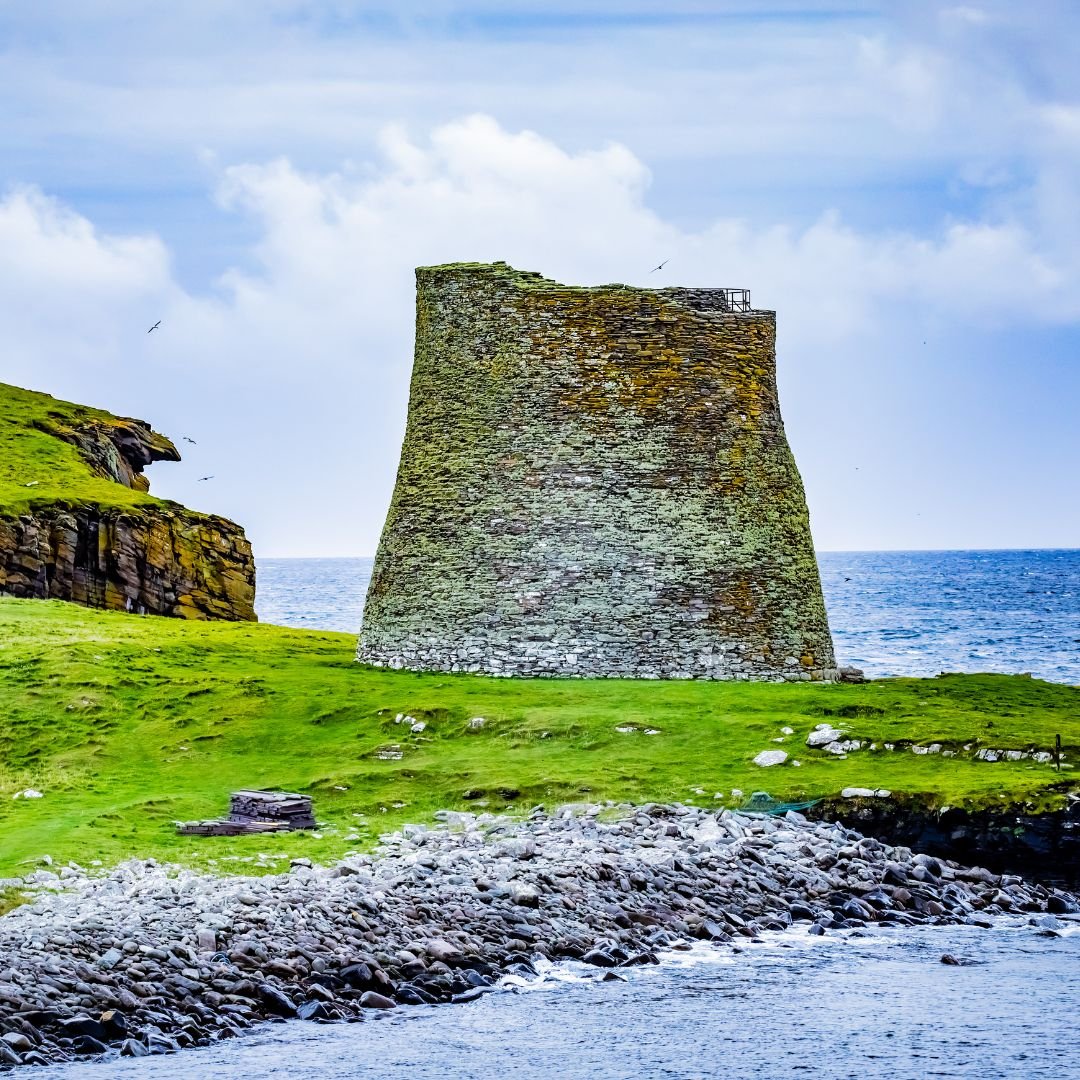Broch of Mousa, Scotland: One Of The Best-Preserved Prehistoric Buildings in Europe
The Broch of Mousa is the tallest broch in the world and one of the best-reserved prehistoric buildings in Europe.
Now a scheduled monument, it’s situated on the island of Mousa, Shetland and it’s thought to have been constructed around c. 300 BC.
We don’t know whether Mousa was the apogee of broch building, or if there were other broch towers of this height and strength that, for whatever reason, did not survive.
Brochs are a kind of Iron Age roundhouse found only in Scotland - and there are 500 of them scattered across the country.
Brochs combine features of fort, fortified house, and status symbol, and could easily have served different purposes in different places and at different times.
Out of all Scotland's broch’s one quite literally stands supreme: Mousa Broch rises to 13m high and is both magnificent and awe inspiring.
Mousa is the only broch to retain its full internal stair and to stand to its original height.
Today, visitors can still climb the staircase to marvel at the commanding view and workmanship of this 2000 year-old building.
Mousa Broch has one of the smallest overall diameters of any broch, as well as one of the thickest wall bases and smallest interiors.
This massive construction (as well as its remote location) is likely to be the main explanation for its excellent state of preservation.
It’s an amazingly complex building, and it is remarkable just how much of it has survived intact.
Once inside, a visitor may ascend an internal staircase to the top - it is the only broch which is complete nearly to the top, including the original intramural stair.
The entrance is on the west side but has been altered at various times from its original appearance, the entrance passage is just 5 metres (16 ft) long and still has an original bar-hole.
Once inside it is difficult to understand how people might have lived within what resembles nothing so much as a power station cooling tower.
The remaining fixtures and fittings, such as they are, give little help, for these largely date back to a later "wheel house" constructed within the walls of the broch, probably in the Pictish period.
Within the huge thickness of the base of the walls are a range of chambers probably used for storage, while at higher levels passages run between the inner and outer skins of the wall.
Each chamber has stone cupboards, or recesses, built into the walls, and extra openings over the doorway lintel to allow air and light inside.
Opinions differ about whether this was to ensure that the sheer mass of the walls didn't cause the broch to collapse; or simply an anticipation by 2000 years of the invention of double glazing.
There are 6 galleries, accessed by a stair at the second level, and there is also a small cell over the entrance passage.
It is possible to walk along most of the galleries - they were probably used by the builders as an aid to constructing the building, rather than for accommodation or storage.
In its original condition it may or may not have contained a wooden roundhouse resting on the scarcement ledges and presumably on a ring of posts set into the primary floor.
It has recently been argued that the scarcements may have supported scaffolding in a roofless building.
At a later date, if the wooden building existed, it was demolished to make way for a small wheelhouse (with three projecting stone piers) in the interior.
Scarcement ledges at heights of 2.1 and 3.7 metres (6.9 and 12.1 ft) might have supported the putative timber building.
Mousa Broch continued to be used over the centuries and is mentioned in two Norse Sagas.
Egil’s Saga tells of a couple eloping from Norway to Iceland who were shipwrecked and used the broch as a temporary refuge.
The Orkneyinga Saga gives an account of a siege of the broch by Earl Harald Maddadsson in 1153 following the abduction of his mother, who was held inside the broch.
The site was visited by the antiquarian George Low during his tour of 1774, and he provided the first drawings of the broch.
It was visited by Sire Walter Scott in 1814, who described it as "a Pictish fortress, the most entire probably in the world."
Mousa was cleared of debris and repaired in 1861 and great quantities of animal bones, especially of otters (which probably inhabited the deserted ruin) were found.
Also found were pieces of a clay pot, stone pot lids, a slaty stone about 12 inches long "like a three-cornered file" and a "carved model of a Norway boat in fir" about 3 feet (1 metre) long.
The interior was cleared again by the Office of Works in 1919, and few additional finds emerged.
In the National Museum of Scotland in Edinburgh are some pottery sherds, including a large black-burnished rim sherd, probably found during the 19th century clearance.
Today, Mousa Broch is well known among birders for its breeding European storm petrels, which are best seen after dark on partly or on completely overcast summer nights.
The island holds around 6,800 breeding pairs in total, representing about 8% of the British population and about 2.6% of the world population.
Some of these birds nest in burrows within the broch itself.
If you’d like to visit this incredible structure, Mousa is only accessible by boat - a ferry operates April to September from Sandsayre, Leebitton and is run by Mousa Boat Trips.
They offer trips during the day and unique, night-time trips to see the nocturnal storm petrels returning to their nest sites in the broch.
The ferry across Mousa Sound takes about 15 minutes.
The broch has great reviews on TripAdvisor, someone who recently visited said: “We visited Mousa on a beautiful sunny day and were very impressed.
”2,500 years old and the only Broch in this condition in Shetland - it’s amazing. We took the Mousa Boat over (£18) and spent the afternoon there. We would go again - one of the most amazing sites on Shetland.”
Mousa has many stories to tell in its long history some of which may be myths, but one thing we do know, a visit to this delightful island will have a special place in your memory for a long time to come.
It’s certainly worth a visit if you’re planning a trip to the Highlands! :)
If you enjoyed this blog post, please follow Exploring GB on Facebook for daily travel content and inspiration.
Don’t forget to check out our latest blog posts below!
Thank you for visiting Exploring GB.



















